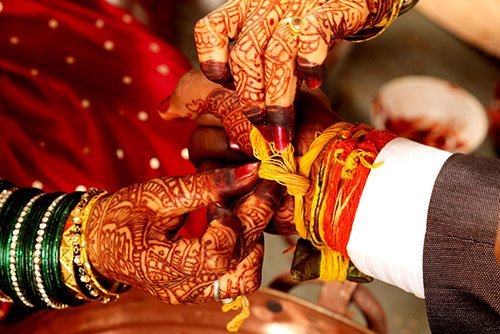This article is written by Ishan Arun Mudbidri, from Marathwada Mitra Mandal’s Shankarrao Chavan Law College, Pune. This article talks about the concept of bigamy under Indian Law.
Table of Contents
Introduction
India is known for its rich cultures and diverse traditions. Marriages in India are considered a pure bond of love that brings two lives together. However, all marriages have problems and sometimes these problems may lead to extra-marital affairs, bigamy, divorce, etc. Out of all these, bigamy is considered an offence under the Indian legal framework.
Concept of bigamy before the Hindu Marriage Act, 1955
Bigamy was prevalent in India since the Vedic times. Kings and princes used to marry more than once. Bigamy was prevalent among people from all religions, Hindus, Muslims, Buddhists, Christians, Sikhs. When did the practice of bigamy start is still a mystery. It was never considered an offence until the enactment of the Indian Penal Code in 1860. Section 494 of the IPC explicitly mentions the offence of bigamy. It states that whoever despite having a husband or a wife living, marries again during the lifetime of such husband or wife shall be liable to punishment which may extend up to seven years of imprisonment or fine. Bigamy is a non-cognizable and bailable offence. Section 495 of the IPC also states that concealing the fact of a former marriage by the husband or wife is a punishable offence.
Essential ingredients of bigamy
- The main ingredient of bigamy is the existence of a previously contracted marriage. It is necessary to prove that at the time of the second marriage, the person was already married.
- Both the marriages, first as well as second, should be valid marriages to attract the provisions of this section.
- The second marriage has to be void only because the marriage was done during the lifetime of the first husband or wife, and not for any other reason.
In the case of Sivagami v. S Nagalingam (2000), it was held by the court that, to prove the offence of bigamy under Section 494 of IPC, the following essential ingredients are required:
- The accused must have contracted the first marriage,
- The accused must marry again,
- During the first marriage, the accused must contract a second marriage.
In the case of Venugopal. K v. Union of India (2015), the court held that any person who commits the offence of bigamy will be punished under Section 494 of IPC regardless of what laws he/she is governed by.
It is to be noted that Section 494 does not apply to those cases where the marriage is declared void by a competent court of jurisdiction, nor when such husband or wife has been absent continuously for seven years provided that these are not hidden from the person with whom the second marriage is contracted.
Bigamy under the Hindu Marriage Act, 1955
The enactment of the Hindu Marriage Act in 1955 changed the system of marriages amongst the Hindus. Before the Act, polygamy was accepted amongst the Hindus. This Act prohibited the practice of polygamy. Section 5(i) of the Act states that for a valid marriage both the parties should not have spouses living at the time of marriage. Further, Section 17 of the Act states that any marriage between two Hindus will be void if, at the date of the wedding either party has a husband or a wife living.
In the case Gopal Lal v. State of Rajasthan (1979), the appellant, belonging to the Telli community, after parting ways with his first wife, married for the second time. The first wife filed a complaint and ended the appellant’s conviction under Section 494 of the IPC. The conviction was upheld by the Rajasthan High Court. The case then went to the Supreme Court. It was held by the Supreme Court that a second marriage is void under Section 17 of the Hindu Marriage Act.
Now, Section 7 of the Hindu Marriage Act states that a marriage is said to be complete and valid when both parties have married as per the ceremonies and customary rites mentioned in the Act. These include the Saptapadi ceremony, putting a ring on any finger, tying of the thali, etc. Hence, for the second marriage to be valid requirements of Section 7 must be fulfilled.
In the case Bhaurao Shankar Lokhande v. State of Maharashtra (1965), the court observed that whoever marries means whoever marries validly. If the customary rites and ceremonies, especially the Saptapadi ceremony is not performed, then the marriage will be invalid. The court further stated that, if the marriage is not solemnized, it will not satisfy the condition under Section 17 of the Act. Hence, such marriage would not be an offence under Section 494 of the Indian Penal Code.
Bigamy as a ground for divorce under the Hindu Marriage Act, 1955
Section 13 of the Hindu Marriage Act mentions the various grounds for divorce. There are nine grounds for divorce. Bigamy is not included in these nine grounds. It is because it is an offence that makes the marriage void. The parties involved do not have to file for divorce again because it is understood that bigamy is naturally a ground for divorce.
Relevant case laws
Parameshwari v. Venilla (1999)
In this case, the appellants were punished under Section 494 of the IPC. it was held that bigamy is non-cognizable, bailable, and thus a compoundable offence.
M.Saravana Porselvi v. A.R. Chandrashekar (2008)
In this case, the appellant was married to the respondent and they both were living separately. The parties agreed to divorce and the appellant also received permanent alimony. However, the respondent married again and also had two children. This fact was not known to the appellant. Hence, she filed a petition against the respondent stating that she came to know of the fact of the second marriage at a time when divorce proceedings were still going on. The court held that the criminal proceedings against the offence of bigamy can be set in motion at any time after the registration of the second marriage. There is no limit to when action can be taken against the offence of bigamy.
Sarla Mudgal v. Union of India (1995)
In this case, there were two petitioners. Both the petitioners alleged that their respective husbands married for the second time and converted to Islam for the same purpose thus, avoiding the provisions of Section 494 of the IPC. The Supreme Court observed that a person who was a Hindu had converted to Islam and married again despite not taking divorce from the first wife. Such a marriage is void, and the person shall be punished under Section 494 of the IPC.
Trailokya Mohan v. State of Assam (1968)
The petitioner committed the offence of bigamy and was hence punished under Section 494 of the IPC. The accused who was the petitioner himself had accepted the fact that he committed the offence of bigamy, but the witnesses during the procedure did not make any mention that the second marriage was invalid. Hence, the court observed that a valid second marriage was solemnized and in such circumstances, the basis of the admission made by the accused could be relied upon.
Banshidhar v. Chabhi Chatterjee (1966)
In this case, a Hindu woman claimed to be the wife of the petitioner. The petitioner denied being her husband. After examining, it was found out that the woman is the wife of the petitioner and has a right to claim maintenance. But at the date of marriage respondent, the petitioner was already legally married. Hence, it was held that the petitioner’s marriage with the respondent woman is void under Section 11 of the Hindu Marriage Act. Also, the woman could not claim maintenance because she was not the legally wedded wife of the petitioner. The court further stated that such claims for maintenance have no relevance with the personal laws on maintenance like the Hindu Adoption and Maintenance Act, 1956.
Other personal laws mentioning bigamy as an offence
All personal laws are gender-neutral in the context of bigamy.
Special Marriage Act, 1954
Section 44 of the Special Marriage Act penalizes bigamy under Section 494 and Section 495 of the Indian Penal Code.
Parsi Marriage and Divorce Act, 1936
Section 5 of the Act makes the offence of bigamy null and void.
Foreign Marriage Act, 1969
Section 19 of this Act provides punishment for the offence of bigamy.
There is no provision for the offence of bigamy under the Muslim Personal Law. This is because the Quran allows Muslim males to marry 4 four times.
Bigamy versus polygamy
Bigamy and polygamy are two fishes in the same pond. Both of these are related to marrying more than once. But both these words have a different meaning and scope. Bigamy is a criminal offence when a legally married individual marries for the second time during the life of the first spouse. Polygamy, on the other hand, is not considered an offence. But it is a religious practice where a person has more than one wife at the same time. In polygamy, all the spouses know of each other’s existence whereas, under bigamy, the spouses have no idea their husband has married again.
Further, bigamy is not considered legal in almost all countries whereas, polygamy is considered legal in some countries like India, Pakistan, etc. Punishment for bigamy has been mentioned in various personal laws and codified laws whereas there is no punishment for polygamy.
Bigamy and law of succession
According to the Hindu Law of Succession, in the case of a second marriage during the lifetime of the first wife, the first wife will be the legal heir of her husband’s ancestral property. The second wife will not be liable for any share in the property. The second wife cannot claim maintenance if the marriage is declared void. However, the children of the second wife can have a share in the ancestral property and it is their right.
Grant for injunction
As of now, there are no laws to bring a petition in the context of restraining a person from marrying again. But Section 38 of the Specific Relief Act, 1963 includes a suit for a perpetual injunction which is granted to the petitioner, restraining the respondent from marrying again which would lay in the jurisdiction of the civil court.
Live-in relationships and bigamy
Live-in relationships have gained immense popularity and acceptance in the modern world. However, live-in relationships are taking a negative turn, as married people are entering into live-in relationships. This is seen mostly in Indian men and the wives are unable to prove the relationship because the husband has not married the other woman.
In the case of Indra Sarma v VKV Sarma (2013), the Supreme Court laid down the conditions which prove a live-in relationship in India. The court mentioned five conditions which were:
- A domestic relationship between an adult male and female who are unmarried.
- A domestic relationship between a married man and an unmarried woman is entered unknowingly.
- A domestic relationship is entered knowingly between an adult unmarried man and a married woman.
- A domestic relationship between an adult unmarried woman and a married man, which is entered knowingly.
- Lastly, a domestic relationship between same-sex partners.
This decision by the Apex Court proved to be a landmark judgment that paved the way for live-in relationships in India.
In the case of Khushboo v. Kanniammal (2010), the appellant was an actress who made some remarks regarding premarital sex and live-in relationships in a famous magazine. Hence, various criminal proceedings were filed against her. She then approached the court to quash these proceedings. The court observed that living together is not illegal in the eyes of the law even though it is considered to be by Indian society. The court further stated that living together is a right to life.
In the case of Tulsa & Ors. v. Durghatiya & Ors. (2008), the appellants approached the court to argue that they were not given a share in any property left by their parents, whose marriage was disputed by their rival claimants who were the respondents for this case. The court held that the children born in a live-in relationship cannot be called illegitimate. The court further granted a right to property to such children.
In the case, Rameshchandra Daga v. Rameshwari Daga (2004), the appellant’s husband got married to one Usha and had three kids with her. The respondent’s wife, who was not married before, married one Girdhari Lal. According to the wife of the respondent, the ceremonies of a valid marriage were not finished. Hence, she filed for divorce which was rejected by the court. So, a disintegration of marriage was executed between her past husband and the wife. Later, both of them got married and also delivered a child. But due to domestic violence by her husband, she left his house and started living with her father. She then claimed maintenance from her husband. The husband also contended that at the time of his second marriage, his wife’s first marriage was not yet dissolved and also claimed whether their child was legitimate. Both the parties filed a cross-appeal in the Supreme Court. The court upheld the maintenance of the rights of women.
Hence, the law of bigamy does not hold true in the case of live-in relationships as there is no legal marriage between the parties involved.
Conclusion
Bigamy exists in societies where it is legally accepted. For example, the Hindu, Parsi, Christian personal laws have imposed punishments for the offence but there is no prohibition on bigamy under the Muslim Personal Law. There are still some loopholes that must be filled up. The rules for bigamy do not mention the rights and duties of the people in a live-in relationship. Due to this, married men in a live-in relationship take advantage and the wife of the person has nothing to prove against him. Despite all this, the practice of bigamy has reduced to a great extent in recent times, and the future hopes to be bright.
References
Students of Lawsikho courses regularly produce writing assignments and work on practical exercises as a part of their coursework and develop themselves in real-life practical skills.
LawSikho has created a telegram group for exchanging legal knowledge, referrals, and various opportunities. You can click on this link and join:
 Serato DJ Crack 2025Serato DJ PRO Crack
Serato DJ Crack 2025Serato DJ PRO Crack










 Allow notifications
Allow notifications



